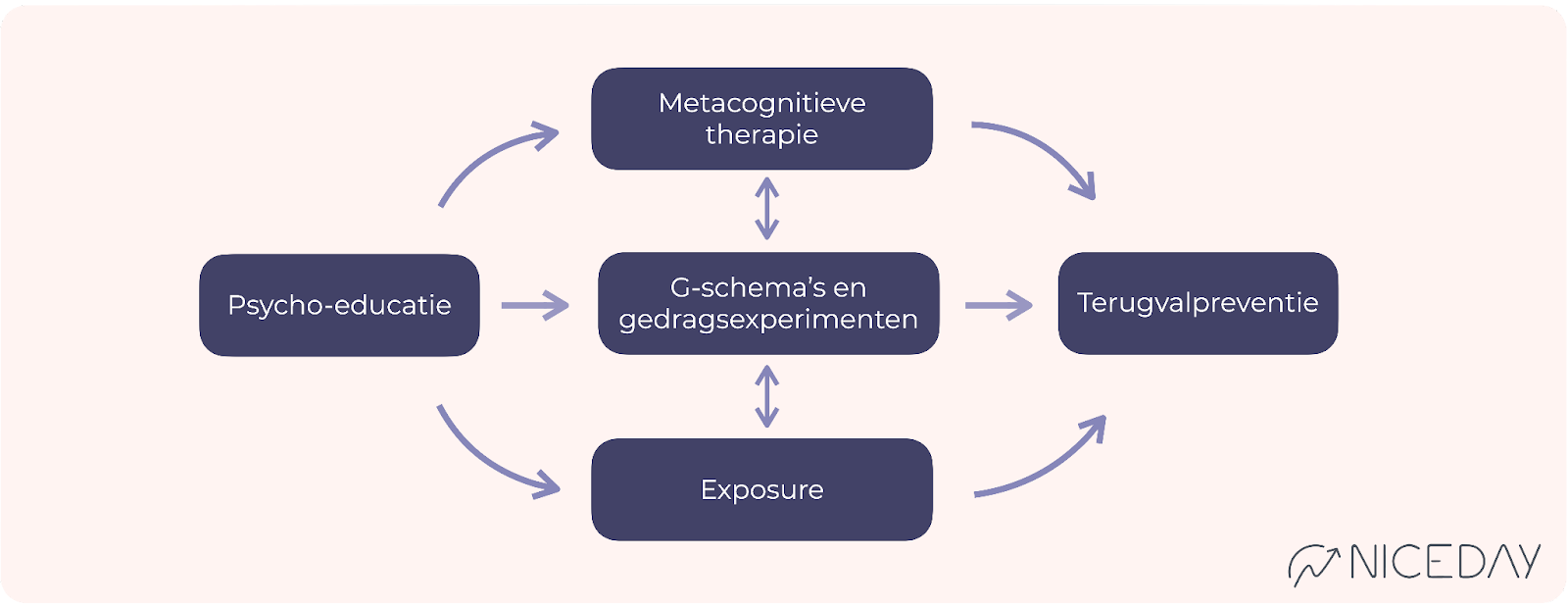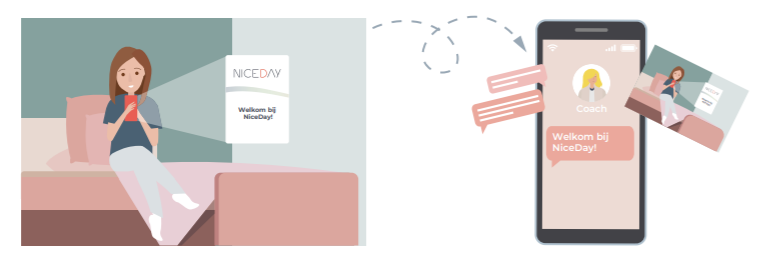Generalized anxiety Protocol
This protocol for generalized anxiety is built on core interventions. It can be implemented online or in a blended format and is based on existing protocols, scientific sources, and mental health care standards, using NiceDay. In this treatment, you emphasize strengths, enhance confidence, and encourage an active work attitude. Additionally, you facilitate autonomy through encouragement and motivation, shared decision-making, and involving loved ones. Based on your client's personal situation and complaints, you can utilize supporting articles, and inspiration for these can be found at the end of the protocol.
This protocol provides therapists with guidelines and inspiration for what is possible within NiceDay. The protocol consists of core interventions that can be implemented based on the therapist's assessment. Therefore, the protocol does not have to be strictly followed but can be adapted to the client's situation and complaints.
Core Interventions
The treatment of Generalized Anxiety Disorder (GAD) consists of the following core interventions:
🔥 Exposure
🧪 Thought records and Behaviour Experiments
🧘 Other Interventions for Generalized Anxiety:
- Acceptance and Commitment Therapy
- Mindfulness
- Relaxation exercises
- Teaching problem-solving skills (exercise)
- Pharmacological therapy can be used in conjunction with CBT treatment, depending on consultation and agreement.
Order of Treatment
The treatment begins with psychoeducation about generalized anxiety, metacognitive therapy, and/or cognitive-behavioural therapy (CBT). Depending on the therapist's preference, you can choose to start with exposure therapy, cognitive therapy, or metacognitive therapy. For example, if there is a strong avoidance of worrying, exposure therapy may be chosen. If someone has strong or rigid beliefs or engages in a lot of catastrophic thinking, cognitive therapy may be chosen. If your client has various strong negative or positive beliefs about worrying, you can start with metacognitive therapy. Of course, it is also possible to combine different core interventions.
Pace and Frequency
Depending on the severity of the symptoms and the effectiveness of the therapy, the duration can be approximately 10 to 15 sessions. It is advisable to schedule frequent sessions at the beginning of the treatment. It is important, in terms of expectation management, to make agreements with your client about the duration of the treatment.
Outcome Feedback (OMQ and SMQ)
To monitor progress effectively, you can use two short (5-question) questionnaires that are administered around each session. Prior to each session, the Outcome Measurement Questionnaire (OMQ) assesses the severity of the symptoms. After each session, the Session Measurement Questionnaire (SMQ) evaluates the quality of the treatment session and the working relationship. You can find the manual here. If necessary, discuss the results with your client.
Flexible Time
Flexible time refers to the time you spend with your client outside of the sessions (e.g., chatting, sending psychoeducation, or writing session notes). This allows you to stay engaged with your client and monitor progress effectively. You can assess how much time is needed per client. If you need more inspiration for what you can do, refer to this article.
Within the flexible time, there are several standard actions per session:
|
Involving Social network
Discuss with your client whether and how their social network can be involved in the treatment process. The client's environment can both facilitate and unintentionally hinder the treatment process by maintaining avoidance and safety behaviours. You can find information on how to involve the social network in the treatment process here.
📖 Psychoeducation Core Intervention
The goal of Psycho-education is to provide your client with information about social anxiety and prepare them for one of the core interventions by initiating symptom monitoring. This typically takes about 1-2 sessions on average.
Deepening Psychoeducation Core Intervention
Flexible time - prior to the first session: 5 minutes Welcome message
Sharing Psychoeducation
|
Session (1 or 2 sessions) 35 min
What can you do?
- Explain outcome feedback (OMQ and SMQ)
- Discuss psycho-education and check for any questions.
- Discuss the treatment goal with the client.
- Explore the possibility of involving the social network in the treatment.
- Collaboratively establish SMART treatment goals and, if necessary, create crisis plans.
- Enable trackers in consultation with the client, such as:
Worrying, Avoidance, Anxiety or Safety Behaviours
This allows you to monitor and assess patterns of worrying, avoidance, or safety behaviours in preparation for the next sessions. - Discuss the importance of tracking worrying and avoidance behaviours with the client.
- Schedule the next session(s) in consultation with the client. Enable OMQ and SMQ.
- Examples of exercises and assignments for home practice:
- Ask the client to write a session note and explain how to do it.
- Encourage the client to read the provided psycho-education materials if they haven't done so already.
- Share psycho-education about anxiety with the client's significant others.
- Ask the client to complete the SMQ after the session.
Flexible time 15 min How can you fill in this time during the week?
|
🔥 Core Intervention Exposure
The goal of Exposure is to expose your client to anxiety-provoking situations. Together, you identify the situations that are being avoided, and then repeatedly practice engaging with these situations. This typically takes a minimum of 4 sessions on average.
Deepening core intervention exposure
Flexible time - before the first exposure session 5 min
|
Session 1: 35 mins
- Explain Exposure therapy Together with your client, identify the situations and activities that are avoided or tolerated with high levels of distress. You can use registered safety behaviours and/or avoidance as a starting point for this discussion.
- Choose an anxiety-provoking situation together with your client to practice with. It can be challenging, but it should be manageable enough for your client to engage in.
- Plan the exposure exercise together in NiceDay and ask the client about their anxious "if-then" expectations.
- Worry exposure imagination: repeatedly exposing yourself to the most feared outcome.
- Worse-case scenario worrying 1) postponing worrying until a designated time to engage in as much worrying as possible.
- Worse-case scenario worrying 2) no designated time, but intentionally intensifying worrying spontaneously.
- Response prevention: exposing your client to anxiety-provoking situations and preventing their typical response.
- Examples of exercises and assignments to do at home:
- Perform the agreed-upon exposure exercise.
- Record a list of anxious situations in the diary.
- Continue to track and record worrisome thoughts, avoidance, and safety behaviours.
Flexible time 20 min
|
Session 2 to 4 30 min
- Evaluate how the exposure exercises are progressing.
- Review the list of anxiety-provoking situations together and agree that the client will perform a daily exposure exercise from the list in the upcoming week.
- Plan which exercise will be done when, either by yourself or let the client decide.
- Continue discussing the results of all activated trackers.
- Discuss the exercises and assignments for home:
- Schedule and perform the agreed-upon exposure exercises and record how they went.
- Continue filling out the activated trackers.
Flexible time 20 min
|

🧪 Core Intervention Thought records and Behavioural Experiments
The goal of Thought Records and Behavioural Experiments is to examine and test the impact of unhelpful thoughts on unwanted emotions or behaviours, and evaluate them based on reality. You identify and challenge unhelpful thoughts using Thought Records, and design behavioural experiments to practice new behaviours. On average, this process takes at least 6 sessions.
Deepening core intervention Thought records
Deepening core intervention Behavioural experiments
Flexible time - prior to the first session 5 min
|
Session 1: 35 mins
- Check if there are any questions regarding the shared psychoeducation materials.
- Explain the influence of anxious cognitions using personal examples, for instance, "If I don't worry, things will go wrong."
- Explore the anxious cognitions related to anxiety-provoking situations using the Socratic method.
- Fill out Step 1 of the Thought record in NiceDay together. Check with your client if they understand the Thought record clearly.
- Examples of exercises and assignments for home::
- Fill in step 1 of the Thought record for anxiety-provoking situations.
- Ask your client to continue recording their worrying thoughts, avoidance behaviours, and safety behaviours.
Flexible time 20 min
|
Session 2: 35 mins
- Discuss the exercises and assignments that were done at home and evaluate step 1 of the Thought record together with the client.
- Introduce steps 2 and 3 of the Thought record using psycho-education on challenging thoughts in a Thought record. Then, you can work together to challenge a thought using a previously filled Thought record.
- Provide an explanation, if necessary, about thinking styles or lifestyle.
- Examples of exercises and assignments for home:
- Fill in steps 1 to 3 of the Thought record for anxious situations.
- Ask your client to set a daily reminder for the Thought record, as a reminder to fill it out.
- Encourage your client to continue registering worrying, avoidance, and safety behaviours.
Flexible time 20 min
|
Session 3: 35 mins
- Discuss the exercises that have been done at home and encourage your client to continue filling out the Thought records.
- Discuss the helpful thoughts and insights gained. Use this as a bridge to behavioural experiments.
- Review the overview of the number of registered "worrying," avoidance, and safety behaviours in the graphs in NiceDay to discuss the impact of the interventions. Additionally, the OMQ can visualize progress.
- Explain behavioural experiments.
- Explain why it is important to start experimenting with different behaviour from now on. Ask what someone else would do if they were guided by these new helpful thoughts.
- You can also choose to use the registered patterns of excessive worrying, safety behaviours, and/or avoidance as inspiration for behaviour experiments.
- Together, create a first behaviour experiment and schedule it in NiceDay. Both of you have the option to schedule it.
- Examples of exercises and assignments for home:
- Continue practicing steps 1 to 3 of the Thought record.
- Perform the behaviour experiment and record it in NiceDay.
- Keep monitoring and recording excessive worrying, avoidance, and safety behaviours.
Flexible time 20 min
|
Session 4 to conclusion 35 min
- Discuss how the first behaviour experiment went.
- Encourage your client to continue filling out the Thought records.
- Collaborate on creating more experiments for your client to practice (preferably as many as possible). You can find examples of behaviour experiments and guidance on how to formulate them in the Knowledge Base.
- Examples of exercises and assignments for home:
- Continue filling out Thought records.
- Conduct the behaviour experiments and record them in NiceDay.
- Ask your client to make a session note about this session.
- Continue monitoring and recording instances of rumination, avoidance, and safety behaviours.
Flexible time: 20 min
|
🧠 Core Intervention Metacognitive Therapy
The core intervention Metacognitive Therapy aims to investigate and challenge the role of so-called metacognitions. You identify the metacognitions present and then challenge them using cognitive and/or behavioural techniques. On average, this process takes at least 4 sessions.
Deepening core intervention Metacognitive therapy
Flexible time - before first Metacognitive Therapy session 5 min
|
Sessie 1: 35 min
- Explain the rationale of Metacognitive Therapy and keep the model handy.
- Try to fill in the model together with your client using the questions from the core intervention or assessment measures such as the Penn State Worry Questionnaire (PSWQ) and the Meta Cognitions Questionnaire (MCQ). You can also assign this as homework.
- Homework assignments:
- Ask your client to record any remaining questions or components of the model in a diary entry.
- Ask your client to record metacognitive thoughts in the diary.
Flexible time: 20 min
|
Session 2: 35 mins
- Discuss OMQ and SMQ and create the agenda together.
- Discuss the homework and, if necessary, complete the model together.
- Introduce the "what-if" exercise and/or the white bear (pink elephant) experiment.
- Explain the difference between worrying and solution-focused thinking and ask for examples.
- If you haven't done so already, introduce tracking worries. You can enable the "Worry" tracker for this.
- Exercises and assignments for home:
- Ask your client to come up with two positive scenarios for each negative "what-if" scenario.
- Have your client keep track of the level of their worrying using the "Worry" tracker.
Flexible time 20 min
|
Session 3: 35 mins
Discuss how the exercises and assignments at home are going.
To explore and challenge negative metacognitions or perceived threats, you can use the following cognitive techniques:
- Socratic dialogue to examine beliefs about the uncontrollability of worrying
- Fill in Thought record
- Worry-delay experiment.
- Pros and cons.
- Dissonance technique to juxtapose positive and negative metacognitions about worrying.
To test negative metacognitions or presumed threats, you can employ the following behavioural techniques:
- Worse worrying 1) Postpone worrying until a fixed moment to engage in as much worrying as possible.
- Worse worrying 2) No fixed moment, but consciously intensify spontaneous worrying.
- Mini-research on worrying.
To explore and challenge positive metacognitions, you can utilize the following cognitive techniques:
- Pros and cons.
- Retrospective mismatch to examine whether an old prediction has come true.
To examine and challenge positive metacognitions, you can employ the following behavioural techniques:
- Prospective mismatch to investigate whether a new prediction comes true.
- High vs. low worrying experiment.
- Examples of exercises and assignments for home:
- Fill out the Thought record.
- Schedule and carry out experiments.
- Track exercises in the Diary.
- Continue with the registration of worrying.
- Continue with the exercise of shifting from worrying to problem-solving.
Flexible time 20 min
|
Session 4 to end 35 min
- Discuss the homework from last week.
- You can choose to continue with the exercises until the desired effect is achieved or do additional exercises.
Evaluate the effect of metacognitive therapy and the insights gained after 5 sessions. You can use the recorded worrying behaviour, for example, to assess the effectiveness of the intervention. If the intervention is effective, continue until the new cognitions and behaviours are more or less "anchored," and the treatment goals are (largely) achieved. If you notice that the therapy, despite the efforts of both the client and yourself, has insufficient effect, discuss this with the client and in the multidisciplinary team meeting. Explore possible causes and adjust the therapy if necessary.
🔁 Core intervention Relapse prevention
The goal of Relapse Prevention is to map out how someone can recognize and monitor potential relapse, identify their pitfalls, and provide them with tools to deal with symptoms or situations. This typically takes about 1-2 sessions.
Deepening core intervention relapse prevention
Before the first session on relapse prevention, allocate 5 minutes of flexible time.
|
Session (1 or 2 sessions) 35 min
- Reflect on the progress of the OMQ and SMQ assessments and discuss any other (ROM) questionnaires if applicable.
- Evaluate the treatment:
- Discuss the effect of the treatment.
- Which obstacles have been overcome and which are still present?
- Predict and normalize: It is normal to experience anxiety again in the future. Stress, fatigue, and/or changes in your life can play a role in this.
- Create the relapse prevention plan together:
- Make a list of situations and challenges where the risk of relapse into old behaviour is present.
- Have your client write down a strategy for each situation that can be applied in these specific circumstances.
- Exercises and assignments for home:
- Encourage your client to continue applying everything they have learned. Remind them to continue using the app, such as filling out trackers, to remain vigilant about the amount of worrying, avoidance, and safety behaviours, and to use the Thought record to challenge unhelpful thoughts.
- Ask your client to complete the relapse prevention plan.
Flexible time 20 min
|
📚 Use articles
Based on your client's personal situation and concerns, you can utilize supportive blogs written by professionals and individuals with lived experiences, which can be found on niceday.app. Some topics to consider are:
- Exercise: from worrying to solutions.
- Affirmations against your anxious thoughts
- Am I a control freak? Learn to let go of control!
- Fear about fear
- Feeling mentally tense...? Seek physical relaxation!
- Thinking patterns in anxiety
- Four tips for a better self-image.
- Unsure: 6 tips!
- Living with uncertainty
- Avoidance: short-term relief for your long-term problems.
- Doom thinking
Sources
https://www.ggzstandaarden.nl/uploads/side_products/5dad015bbd8075d0f3e1e65dc11c620d.pdf
Ladouceur, R., Dugas, M. J., Freeston, M. H., Léger, E., Gagnon, F., & Thibodeau, N. (2000). Efficacy of a cognitive–behavioral treatment for generalized anxiety disorder: Evaluation in a controlled clinical trial. Journal of consulting and clinical psychology, 68(6), 957.
Covin, R., Ouimet, A. J., Seeds, P. M., & Dozois, D. J. (2008). A meta-analysis of CBT for pathological worry among clients with GAD. Journal of anxiety disorders, 22(1), 108-116.
Keijsers, G. P. J., Van Minnen, A., Verbraak, M., Hoogduin, C. A. L. & Emmelkamp, P., (2021). Protocollaire behandelingen voor volwassenen met psychische klachten.


